“Gardening” is a bit of a stretch for what I did today as I walked the property, but it’s all I can do. With everything cold and sleeping, today’s tasks included checking staked trees for girdling and rodent attacks. I scraped a liquified but frozen dead mouse (mousesicle?) out of the crawlspace entry, and pruned still-more cicada damage out of the dogwoods. Most of my time was spent shoveling and sweeping the house garden’s mulch and compost back into place. The chickens are doing their winter thing, which is scratching in the loosest, most fertile and worm-filled soil of the acres they have access to—which happens to be in my garden. Of course. All this chicken activity exposes the prenatal tips of spring flowering bulbs, all pale and startled-looking to be so untimely unearthed.

So I go around and cover these little tips with compost and try to move and pat everything into place with reassurances: “Not quite yet, naked ladies, hold tight for a few more months and if any of those chickens take a nip, bite back.” Even as I tuck these shoots away it’s hard to contain my excitement that something’s happening under the dirt. Those promises sowed in November are halfway toward realization.
I’m itching to take the pruners to some of the standing dead perennial foliage that’s dragging the ground, but I learned my lesson last year when I lost track of where I’d planted certain things and smothered them under a new mulch application. So the stragglers stand, marking the location of my plants at least until I get the spring mulch down. I’m trying to view these dried-out sticks and seed heads through the naturalistic lens of some of my favorite garden designers, who design entire landscapes to be appreciated just like this in winter.
The best-looking thing in the garden right now is almost microscopic: my sedum. Sedum “Angelina” has taken on fantastic rainbow colors, and some unnamed small pink sedum is positively fluorescent.

It looks like the polar vortex of a couple weeks ago has already claimed some casualties. My Distylium “Blue Cascade,” which is being heavily marketed as an evergreen landscaping shrub suitable for zones 6b-9, is showing an aesthetically distressing but intellectually interesting pattern of winter burn that wasn’t there before we had our flirtation with zero degrees.
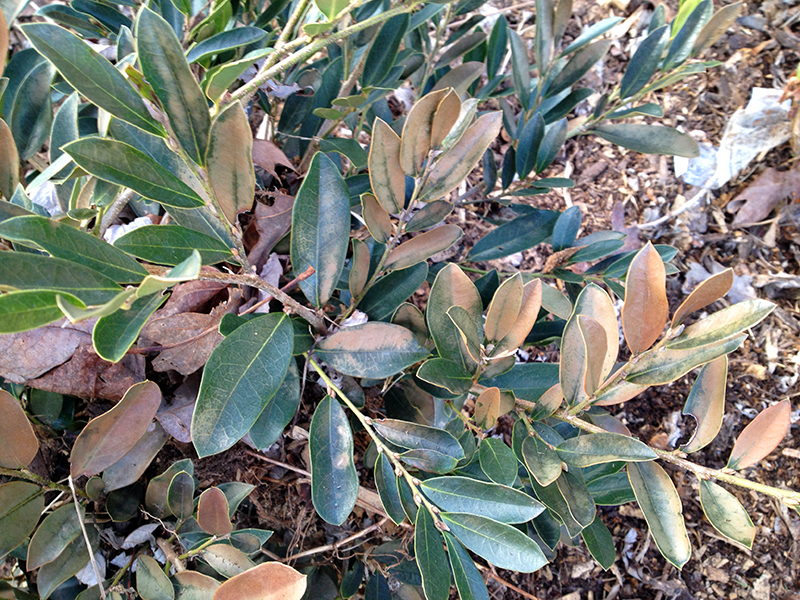
It will be interesting to see how it recovers—good thing I stuck just two of these shrubs in to trial instead of relying on them to carry an entire foundation planting.
And one of my two large clumps of rosemary decided that zero degrees just isn’t a Mediterranean climate, and it’s begun to brown out in a serious way.
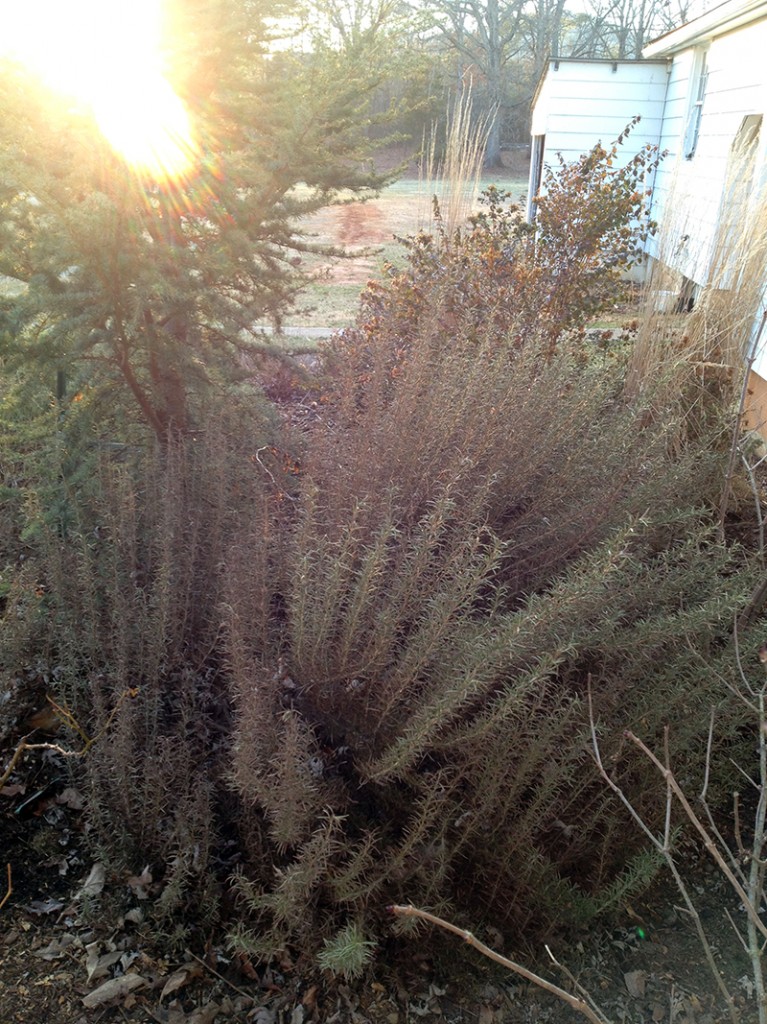
I admit that this big clump, which began as three smaller plants, wasn’t in peak form heading into winter. It had some sort of mite infestation that, while it wasn’t killing it, wasn’t exactly helping things. The interesting thing is that the other rosemary grouping, less than 20 feet away on the other side of the front walk with a similar exposure, evaded both the mite problem and the damaging effects of the polar vortex. Just like humans, plants with healthy immune systems are better able to withstand environmental stressors.
Is it sick to be excited to rip out the rosemary and have a nice big section to fill with something new? I didn’t ever plan for rosemary to become a foundation planting for me—I wasn’t expecting it to be winter hardy here—but it was (for a while!) and once it got big and took up space and stayed greenish through winter, I let it live. But now that it’s brownish, I have no compunction about pulling it all out come spring. As I’ve said before, I like taking things out of the garden more than I like putting things in. It’s a great feeling to give myself permission to correct course midstream, experiment, modify and adapt, and put new knowledge into practice through good editing.
In early August I was pretty sick of the house garden. Despite all the wonderful rain we’ve had this summer, which is unusual as we’re typically in a drought this time of year, the garden was looking tired. All I had going for me were some pretty garish purple phlox, which I appreciate as they bloomed for weeks and weeks.

However, with no other purple plants in the garden to play off, they looked lonely and out of place. And they were clashing with some ill-placed Crocosmia ‘Lucifer,’ above. All around town I kept eying beautifully blooming gardens, and from studying them I realized I hadn’t planted any mid-to-late-summer flowering perennials.
So off I went on a search for some of the hardiest of these standbys, including echinachea, agastache, coreopsis, monarda, and salvia, among others. It was late enough in the season that I managed to score some of these for 50% off, filling my car with ratty-looking twigs on faith that they had enough life left in them to establish in my garden.
To gain space for this minimakeover, I did some pretty major surgery on some of the existing garden plants. I dug out an entire colony of purple German bearded irises that nestled beside my blue atlas cedar. I was torn about it, as I’d rescued these as just a couple of tubers tossed in my brother’s backyard, and for the past few years they’ve bloomed beautifully each spring and grown into a sizable feature in the spring garden, playing beautifully with the Deutzia ‘Chardonnay Pearls,’ which bloomed at the same time.
 April 2013
April 2013
But this spring they were aflicted with iris leaf spot, and despite a couple of treatments, they weren’t able to shake it.
 August 2013
August 2013
Iris leaf spot won’t affect blooming until late in the game, but it makes the foliage look so ratty that I couldn’t stand it, especially in such a promintent place in the garden. And I am not interested in spraying anything in my garden to keep it looking good. So out they came.
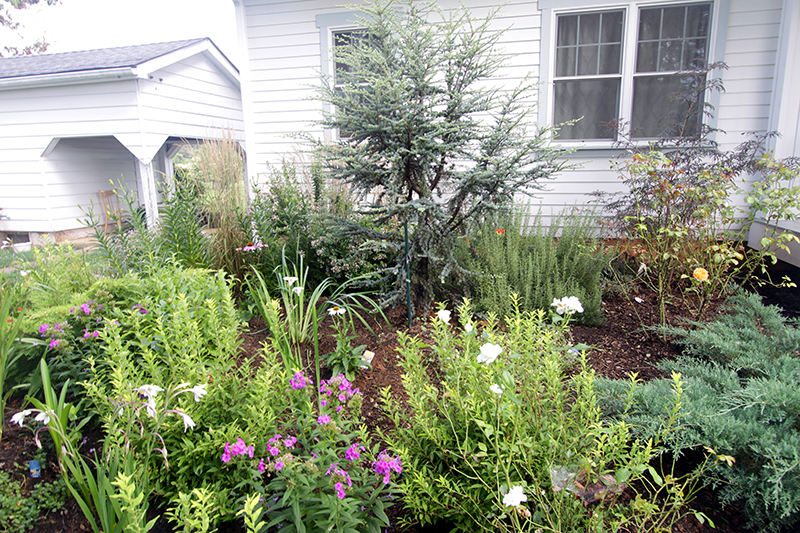
I replaced them with some echinacheas, which won’t give me the same spring bloom but should go crazy all summer. I chose Echinachea purpurea ‘Primadonna Deep Rose,’ for its relatively compact size and gorgeous flower color (not washed out and bland as I find some echinacheas to be) and ‘Primadonna White.’ I added a pot of Siberian iris (Iris sibirica ‘Ceasar’s Brother’). I know it’s a gamble to plant an iris back in the same soil afflicted with a soil-borne disease, but my trusted perennial guide Tracy DiSabato-Aust suggests that Siberian iris are less susceptible to iris leaf spot. I figured it was worth a gamble to return a purple-blue bloom to this place of honor. We’ll see. I also stuck another Siberian iris elsewhere, in unafflicted soil, and added a Japanese Iris (Iris ensata ‘Caprician Butterfly’) just for grins.
While I was on a tear, I also dug up another beloved bearded iris, ‘Precious Little Pink.’ This is a magical plant to me, and blooms in such a weird blue/purple/brown/pink color that’s just indescribable.
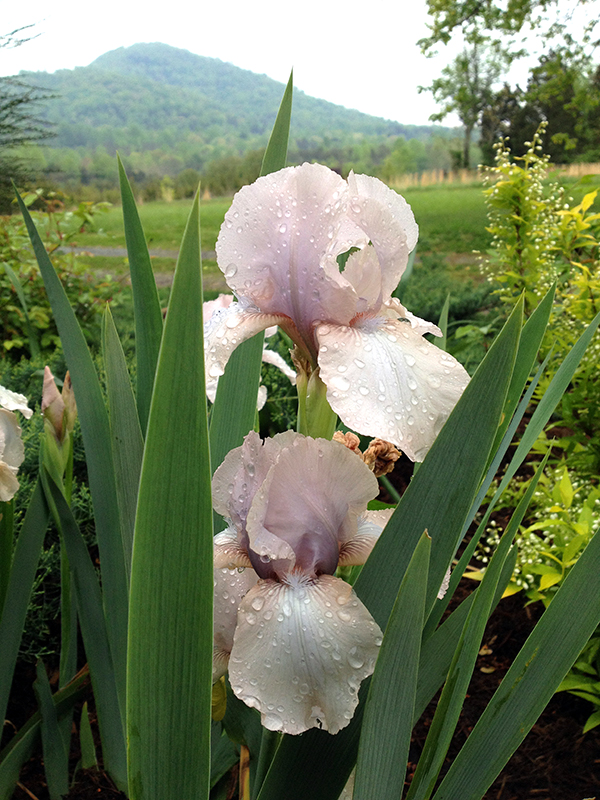 April 2013
April 2013
But it too was afflicted with iris leaf spot, so out it came. When it was out of the ground I discovered it also suffered from some rot and possible iris borer issues. And while I was in the mindset to dig irises, I rectified this unfortunate situation:
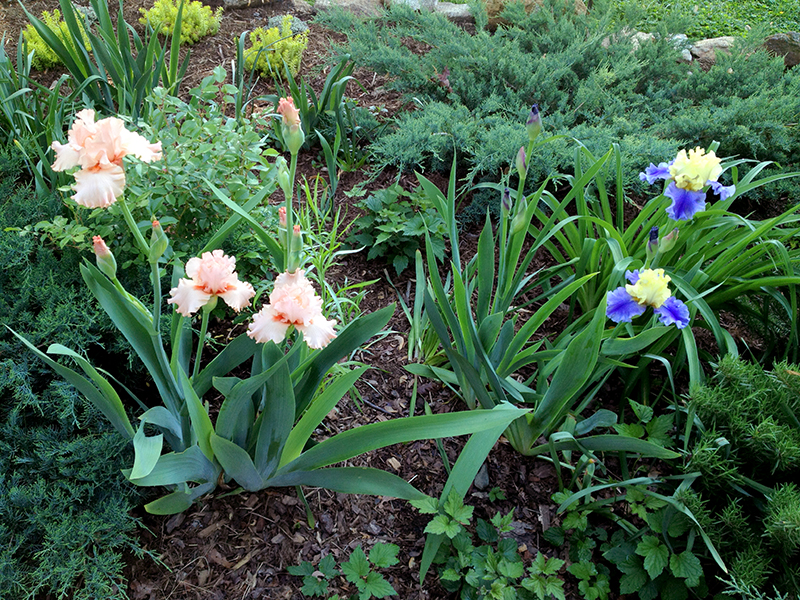
The horribly clashing blue and yellow iris (’Edith Wolford’) was relocated to the drainage ditch along the road, where I hope it will brighten the spring commutes of passers-by.
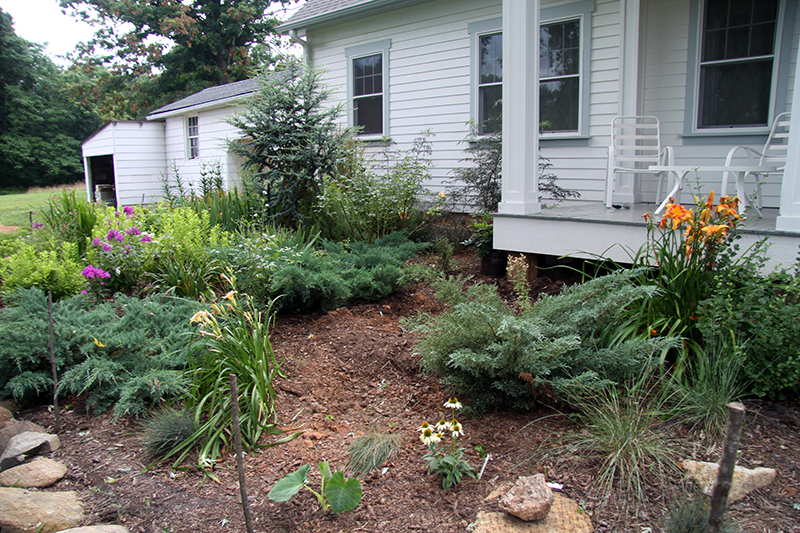
I also dug out all six of my daylilies, shown above along with the holes left from removing the Scotch broom. I had purchased the daylilies before the house was finished, again on deep clearance in the fall, and randomly plopped them in the ground to fill space. This year I finally realized that for the week or so that they bloomed, they took up too much space and looked boring. Plus, I am not a fan of bright orange and schoolbus-yellow blooms in this garden. So the daylilies had to go.

Looking better already! I added a few small evergreen shrubs to replace the Scotch broom. New additions are Nandina ‘Obsession,’ for red fall/winter color (near the porch corner) a relocated Deutzia ‘Chardonnay Pearls’, and a new plant to me, Distylium ‘Blue Cascade.’ (up front next to the elephant ears leaf). I’d been sold on the distylium’s virtues (uncommon deer, drought, clay and insect-resistant evergreen with small red winter flowers) while talking to a plantsman at our local fancy nursery, but he wanted $90 a bush. A few weeks later I found them at the local big-box hardware store for $25. Smaller plants, but that’s okay with me. I am curious to see how it does—it’s being marketed as a new foundation plant. Then I filled in around the new shrubs with a few perennials, including that purple spiky plant, Agastache ‘Bolero.’ It’s just gorgeous–with bronzy foliage and purple-blue blooms. The hummingbirds go nuts for it too. This an the new echinacheas help carry the purple phlox color across the garden.
I’ve still got all the removed iris and daylily tubers resting in the garage, and I plan to plant them back along the woodline. There they can bloom in the spring if they want and I won’t have to be worried about their disease-afflicted foliage later in the season.
It seems as though everything I planted got well-established. I realize things are planted pretty tight, but as you can see I am quite happy to thin and divide if the gardening gods bless me with successful growth. I can’t wait to see what the garden will look like as these flowering perennials begin to fill in and I find out if I was successful at addressing the issues I set out to fix.







 August 2013
August 2013



